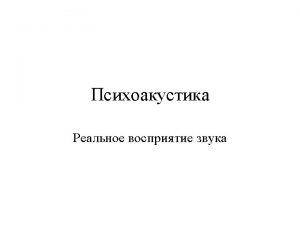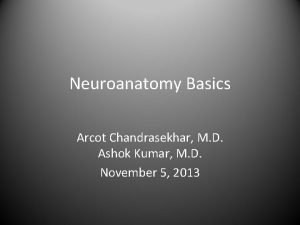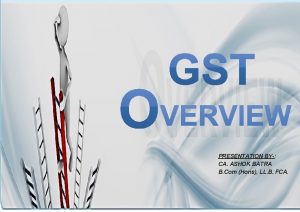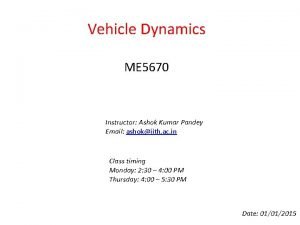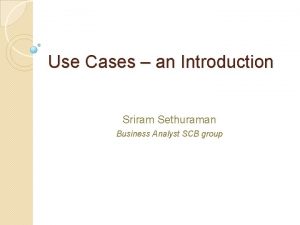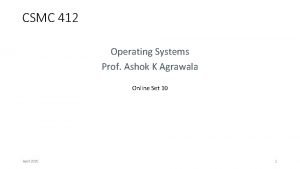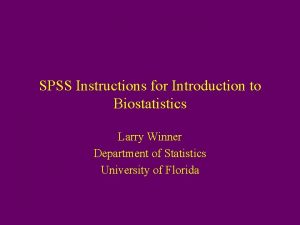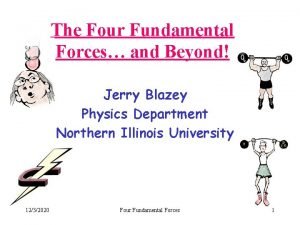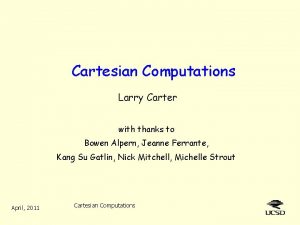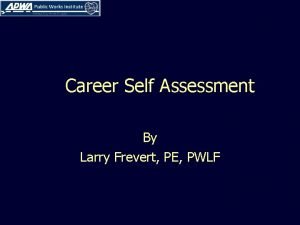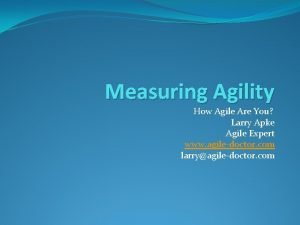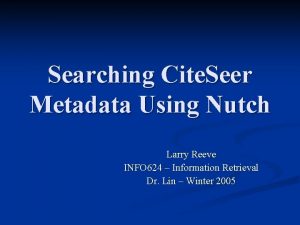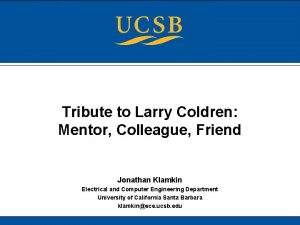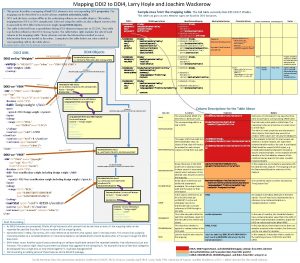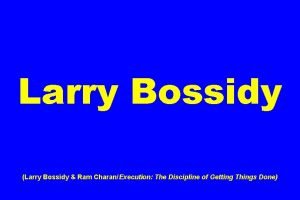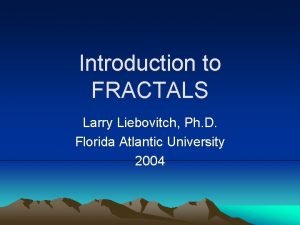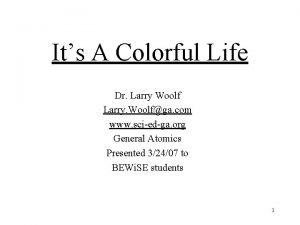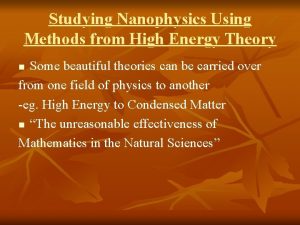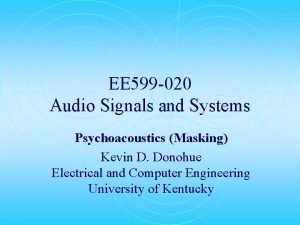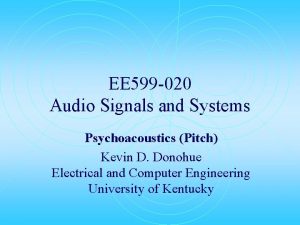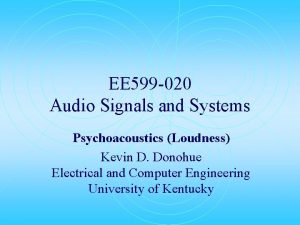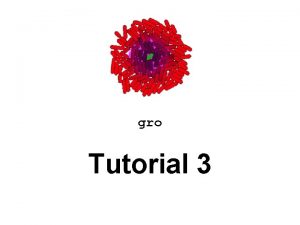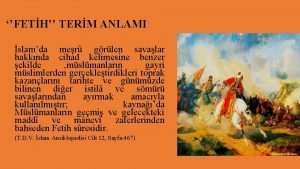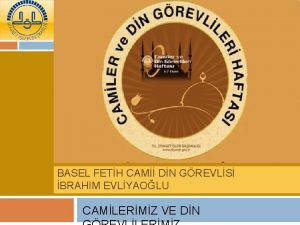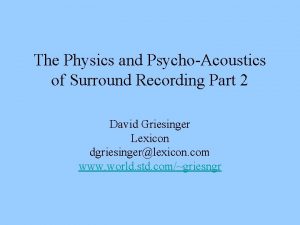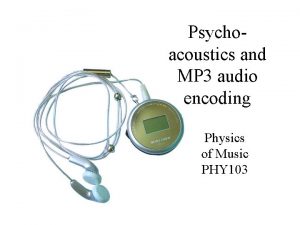Psychoacoustics of Dynamic CenterofGravity Signals Larry Feth Ashok






























![CV Identification Experiment n [da] – [ga] continuum: varying F 3 transition n n CV Identification Experiment n [da] – [ga] continuum: varying F 3 transition n n](https://slidetodoc.com/presentation_image_h2/74a686cc111f98ada8d279d06e1cc84d/image-31.jpg)




















- Slides: 51

Psychoacoustics of Dynamic ‘Center-of-Gravity’ Signals Larry Feth Ashok Krishnamurthy Ohio State University

Spectral Center-of-Gravity n Chistovitch and Lublinskaja (1976, 1979) n Perceptual Formant at ‘Center-of-Gravity’ n n n Two-formant synthetic vowel Matched by adjustable single-formant signal Center frequency of match depends on relative amplitudes of the two formants

Experimental Paradigm

Chistovitch and Lublinskaja Results

Voelcker Two-tone Signals

Voelcker Two-tone Signals n Initially, led to the EWAIF model n Envelope-Weighted Average of Instantaneous Frequency (time domain) n n Point by point multiply E x F values Sum over N periods Divide by sum of weights Indicates pitch change in periodic signals n n Helmholtz (1954, 2 nd English edition) Jeffress (1964)

EWAIF Model

IWAIF Model Predictions

Two-tone resolution task n Feth and O’Malley (1977) n Two-tone resolution n n DI = 1 d. B; Df independent variable ‘Voelcker-tone pair’ pitch discrimination inverted “u-shaped” psychometric functions Components resolved beyond – 75% point ~3. 5 Bark separation = jnnd

Voelcker Signal: Discrimination Task

Discrimination Results n n n Jnnd – ‘Just noticeable difference’ n Filled circles Breakpoint estimates n Open circles CR – critical ratio CBW CB – ‘empirical’ CBW Solid line TW envelope

IWAIF Model Intensity Weighted Average of Instantaneous Frequency = Centroid of signal’s positive power spectrum (Anantharaman, et al. , 1993)

Dynamic Center-of-Gravity Effect n Lublinskaja (1996) n Three-formant synthetic Russian vowels n Listeners identified vowels with: n n n ‘conventional’ formant transitions co-modulated formant pairs that exhibit the same dynamic spectral center-of-gravity ID functions were very similar with formant pairs separated by 4. 3 Bark or less

Psychophysics n Anantharaman (1998) n n n Two-tone signals with dynamic c-o-g effect n We called them ‘Virtual Frequency’ Glides Listeners matched transition rates in VF glides to those in FM glides IWAIF model predicts results for transitions from 2 to ~5 ERB

Dynamic Center-of-Gravity Signals Waveform Long-term Spectrum Spectrogram

Rate-matching results

Model Results

Short-term running IWAIF Model

IWAIF Model Results

Application of ST-IWAIF Model

More Psychophysics n Research Question(s) n n What is being ‘integrated’ in spectral integration? OR Where in the auditory system is the processing located?

Psychophysics n Iyer, et al. , (2001) n Temporal acuity for FM and VF glides n n n Step vs. linear ramp discrimination Similar DT values may mean common process Masking patterns for FM and VF glides n n Peripheral process i. e. , ‘Energy Masking’ Different results – VF not peripheral process

Temporal Acuity Paradigm Step (red) versus Glide (blue) transitions for FM tone (left panel) and Virtual Frequency (right panel)

Temporal Acuity Results Just discriminable step duration for FM (solid lines; filled symbols) and VF (dashed lines; unfilled symbols) signals. Frequency separations are 2, 5 and 8 ERBu. The results for 1000 Hz are represented by circles and those for 4000 Hz by triangles. Average for 4 listeners.

Dynamic Center-of-Gravity Maskers Fh Fh Fc Fc Fl Fl Time Masking of brief probe by FM glide (left panel) and by VF glide (right panel). Probe is in the spectro-temporal center of each masker. Five auditory filter bands are illustrated.

Masking Results Masking of a 20 ms probe by FM (light blue) and VF (darker blue) maskers. The probe is placed at the beginning, middle, and end of the masker. Significant differences are seen at 5 and 8 ERB for the middle position and the initial position at 8 ERB. Average for 4 listeners.

Glide Direction Asymmetry n Gordon and Poeppel n 3 Frequency ranges: (for F 1, F 2 & F 3) n n n ~ 30 unpracticed listeners 20 trials / signal One interval Direction Identification: Up vs. Dn Best results at high frequency (F 3) range n n 10 - through 160 ms ‘Up’ is easier to ID than ‘Dn’ Less clear-cut results at low or mid-freq. ranges

Glide Direction Asymmetry Gordon and Poeppel – ARLO (2002) Identification of FM Sweep direction is easier for rising than for falling tones.

Glide Direction Asymmetry n Dawson, (2002) n n n Tested only high frequency range (F 3) Practiced listeners; ~ 100% all conditions! Modified procedure n n Rove each frequency sweep over 1 octave Practice to ~ asymptote

Glide ID Results n Average for 4 listeners n n n One-interval ID task 250 trials / datum point Well-practiced Subj’s Starting frequency roved over 1 -octave range Summary n n FM ‘easier’ than VF Up ‘easier’ than Down
![CV Identification Experiment n da ga continuum varying F 3 transition n n CV Identification Experiment n [da] – [ga] continuum: varying F 3 transition n n](https://slidetodoc.com/presentation_image_h2/74a686cc111f98ada8d279d06e1cc84d/image-31.jpg)
CV Identification Experiment n [da] – [ga] continuum: varying F 3 transition n n Duration: 50 ms transition into 200 ms base F 3 onset: 2018 to 2658 Hz in 80 Hz steps F 3 base: 2527 Hz (constant) Formant transition ‘type’: n n n Klatt synthesizer Frequency Modulated tone glide Virtual Frequency glide

CV Identification: Stimuli Spectrogram 1. Step 1 of Klatt Monaural Continuum—

CV Identification: Stimuli Spectrogram 2. Step 1 of FM Monaural Continuum—/g

CV Identification: Stimuli Spectrogram 3. Step 1 of VF Monaural Continuum—/ga

CV Identification: Stimuli Spectrogram 4. Step 1 of Dichotic FM Continuum—/ga/

CV Identification: Stimuli Spectrogram 5. Step 1 of Dichotic VF Continuum—/ga/

CV Identification Experiment n Listeners: 8 adults with normal hearing n Procedure: One interval, 2 -AFC n n 3 transition types: Klatt, FM or VF 6 of 8 tokens tested 20 repetitions / token Results are averaged for the 8 listeners

CV Identification: Results

CV Identification: Results

Psychoacoustics of Dynamic ‘Center-of-Gravity’ Signals n n Conclusions ‘Excitation’ is integrated not signal energy The processing is central not peripheral n n n Masking Patterns are very different Temporal Acuity results are similar for FM & VF glides Direction ID Asymmetry is similar for FM & VF glides

Psychoacoustics of Dynamic ‘Center-of-Gravity’ Signals n Conclusions CV identification functions are similar for: n n n Klatt synthesized sounds FM formant sounds VF formant sounds Thus, it doesn’t matter how ‘excitation’ is moved from A to B, the brain will interpret it as the same sound. The effect is evident under dichotic listening; further support for central processing.

Collaborators Rob Fox Ewa Jacewicz Nandini Iyer Jayanth Anantharaman Robin Dawson

Psychoacoustics of Dynamic ‘Center-of-Gravity’ Signals Thank You Questions?

Up vs. Down FM Glide

Up vs. Down FM Glide

Up vs. Down VF Glide

Up vs. Down VF Glide

Effect of Masker Direction Masking produced by VF (above) and FM (below) maskers with D F = 5 ERB. Purple bars are “up” glides; yellow bars are “down” glides. Centered probe.

Effect of Masker Position Masking produced by VF (above) and FM (below) maskers with D F = 5 ERB. Purple bars are “up” glides; yellow bars are “down” glides.

Klatt & FM Parameters

Virtual Frequency Parameters
 Psychoacoustics facts and models
Psychoacoustics facts and models Communicative and informative signals
Communicative and informative signals Communicative signals and informative signals
Communicative signals and informative signals Difference between communicative and informative signals
Difference between communicative and informative signals Jvk rao committee
Jvk rao committee C1 mri
C1 mri Ashok iptv
Ashok iptv Ashok leyland low floor bus
Ashok leyland low floor bus Ashok k. goel
Ashok k. goel Ca ashok batra
Ca ashok batra Ashok kumar pandey iith
Ashok kumar pandey iith Donnie ashok
Donnie ashok Ashok kolaskar
Ashok kolaskar Ashok emani
Ashok emani Ashok sriram md
Ashok sriram md 4 sacred mountains navajo
4 sacred mountains navajo Ashok mankad
Ashok mankad Ashok agrawala
Ashok agrawala Transferered
Transferered Larry made this picture to represent a chemical reaction
Larry made this picture to represent a chemical reaction Nist
Nist Larry winner
Larry winner Fresno state personal statement
Fresno state personal statement Larry bell unraavel
Larry bell unraavel Simbol verbal
Simbol verbal Larry burger
Larry burger Four fundamental forces
Four fundamental forces Larry bowen attorney
Larry bowen attorney Relutante larry
Relutante larry Larry frevert
Larry frevert Larry apke
Larry apke Vdi utsa
Vdi utsa Lawrence larry page
Lawrence larry page Larry rubio riverside transit agency
Larry rubio riverside transit agency Yale program for recovery and community health
Yale program for recovery and community health How to cite seer
How to cite seer Larry maturin
Larry maturin Larry lion alphafriend
Larry lion alphafriend Twelve powerful words
Twelve powerful words Larry coldren
Larry coldren Larry kwak
Larry kwak Larry hoyle
Larry hoyle Larry bossidy
Larry bossidy Hyperbole in the poem pinch
Hyperbole in the poem pinch Overtake
Overtake Larry leeman
Larry leeman Larry liebovitch
Larry liebovitch Larry burd
Larry burd False necessity trap
False necessity trap Larry woolf
Larry woolf I must have drunk four cups of cocoa
I must have drunk four cups of cocoa Larry sulak
Larry sulak
